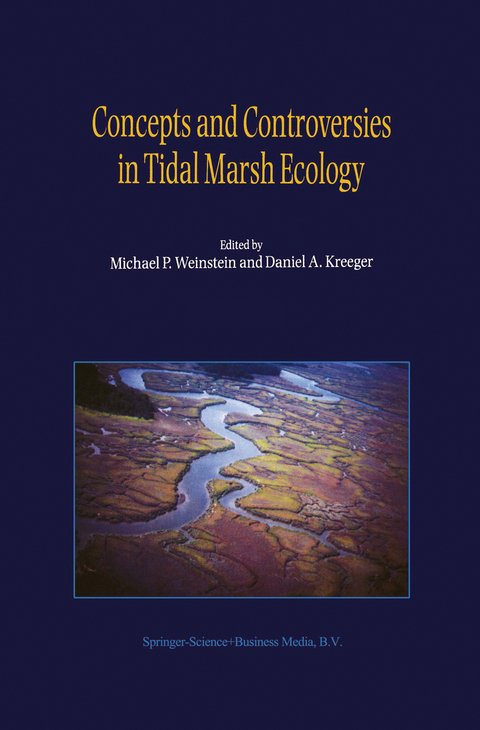
Concepts and Controversies in Tidal Marsh Ecology
Springer (Verlag)
978-94-017-4080-7 (ISBN)
Retrospective on the Salt Marsh Paradigm.- Tidal Marshes as Outwelling/Pulsing Systems.- Salt Marsh Values: Retrospection from the end of the Century.- Sources and Patterns of Production.- Role of Salt Marshes as Part of Coastal Landscapes.- Spatial Variation in Process and Pattern in Salt Marsh Plant Communities in Eastern North America.- Eco-Physiological Controls on the Productivity of Spartina Alterniflora Loisel.- Community Structure and Functional Dynamics of Benthic Microalgae in Salt Marshes.- Structure and Productivity of Microtidal Mediterranean Coastal Marshes.- Development and Structure of Salt Marshes: Community Patterns in Time and Space.- Fate of Production within Marsh Food Webs.- Microbial Secondary Production from Salt Marsh-Grass Shoots, and Its Known and Potential Fates.- Trophic Complexity Between Producers and Invertebrate Consumers in Salt Marshes.- Trophic Linkages in Marshes: Ontogenetic Changes in Diet for Young-of-the-Year Mummichog, Fundulus Heteroclitus.- Habitat Value: Food and/or Refuge.- Factors Influencing Habitat Selection in Fishes with a Review of Marsh Ecosystems.- Salt Marsh Ecoscapes and Production Transfers by Estuarine Nekton in the Southeastern United States.- Salt Marsh Linkages to Productivity of Penaeid Shrimps and Blue Crabs in the Northern Gulf of Mexico.- Ecophysiological Determinants of Secondary Production in Salt Marshes: A Simulation Study.- Salt Marsh Ecosystem Support of Marine Transient Species.- Biogeochemical Processes.- Benthic-Pelagic Coupling in Marsh-Estuarine Ecosystems.- Twenty More Years of Marsh and Estuarine Flux Studies: Revisiting Nixon (1980).- The Role of Oligohaline Marshes in Estuarine Nutrient Cycling.- Molecular Tools for Studying Biogeochemical Cycling in Salt Marshes.- Nitrogen and Vegetation Dynamics in European Salt Marshes.- Modelling Nutrient and Energy Flux.- A Stable Isotope Model Approach to Estimating the Contribution of Organic Matter from Marshes to Estuaries.- Types of Salt Marsh Edge and Export of Trophic Energy from Marshes to Deeper Habitats.- Silicon is the Link between Tidal Marshes and Estuarine Fisheries: A New Paradigm.- Tidal Marsh Restoration: Fact or Fiction?.- Self-Design Applied to Coastal Restoration.- Functional Equivalency of Restored and Natural Salt Marshes.- Organic and Inorganic Contributions to Vertical Accretion in Salt Marsh Sediments.- Landscape Structure and Scale Constraints on Restoring Estuarine Wetlands for Pacific Coast Juvenile Fishes.- Ecological Engineering of Restored Marshes.- The Role of Pulsing Events in the Functioning of Coastal Barriers and Wetlands: Implications for Human Impact, Management and the Response to Sea Level Rise.- Influences of Vegetation and Abiotic Environmental Factors on Salt Marsh Invertebrates.- Measuring Function of Restored Tidal Marshes.- The Health and Long Term Stability of Natural and Restored Marshes in Chesapeake Bay.- Soil Organic Matter (SOM) Effects on Infaunal Community Structure in Restored and Created Tidal Marshes.- Initial Response of Fishes to Marsh Restoration at a Former Salt Hay Farm Bordering Delaware Bay.- Success Criteria for Tidal Marsh Restoration.- Catastrophes, Near-Catastrophes and the Bounds of Expectation: Success Criteria for Macroscale Marsh Restoration.- References is a Moving Target in Sea-Level Controlled Wetlands.- Linking the Success of Phragmites to the Alteration of Ecosystem Nutrient Cycles.- Restoration of Salt and Brackish Tidelands in Southern New England.
| Erscheint lt. Verlag | 4.12.2014 |
|---|---|
| Zusatzinfo | XVII, 875 p. |
| Verlagsort | Dordrecht |
| Sprache | englisch |
| Maße | 155 x 235 mm |
| Themenwelt | Naturwissenschaften ► Biologie ► Botanik |
| Naturwissenschaften ► Biologie ► Limnologie / Meeresbiologie | |
| Naturwissenschaften ► Biologie ► Ökologie / Naturschutz | |
| Schlagworte | algae • benthic • Biogeochemical cycles • Ecology • ecosystem • Ecosystems • Environment • Fauna • fisheries • Macrophytes • nutrient cycling • Sediment • Vegetation • wetland |
| ISBN-10 | 94-017-4080-1 / 9401740801 |
| ISBN-13 | 978-94-017-4080-7 / 9789401740807 |
| Zustand | Neuware |
| Haben Sie eine Frage zum Produkt? |
aus dem Bereich


